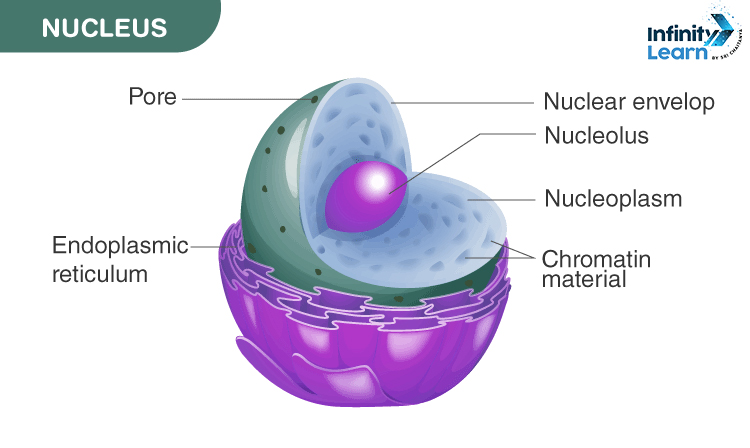Table of Contents
A nucleus diagram for Class 9 shows the nucleus of a cell. The nucleus is like the cell’s control center. It holds DNA, which tells the cell what to do. The diagram shows the nuclear membrane, which is like a protective shell around the nucleus. Inside, there’s nucleoplasm where the DNA lives. Also, there’s the nucleolus, which makes ribosomes, and chromatin, made of DNA and proteins. This diagram helps students see how the nucleus works in a cell.
What is Nucleus
The nucleus is like the brain of a cell, controlling all its activities and functions. It’s a small, round structure found in the center of most cells, and it’s where the cell’s genetic material, called DNA, is stored. Think of it as the control center of the cell, directing everything from growth and reproduction to how the cell interacts with its environment. In Class 9 Biology, the concept of Nucleus plays a important role in understanding the structure and function of cells.
Don’t Miss
- Animal Cell Diagram Class 9
- Human Heart Diagram Class 10
- Neuron Diagram Class 9
- Difference Between Neuron and Neuroglia
- Most Easy and Scoring Chapters of CBSE Class 9 Science
- How To Score Full Marks In CBSE Class 9 Science Exam
Nucleus Diagram for Class 9
A nucleus diagram is useful for learning about its structure and functions. This nucleus diagram for class 9 helps in understanding how these parts work together. In this article, we’ll explore each part and what it does with the help of a nucleus diagram.

Components and Functions of the Nucleus
Nucleus Components and Their Roles:
- Nuclear Envelope: This double-membrane structure encloses the nucleus, acting as a barrier between the nucleoplasm and cytoplasm. It’s studded with nuclear pores that regulate the movement of molecules like RNA and proteins.
- Nucleoplasm: The gel-like substance within the nuclear envelope where crucial processes like DNA replication, transcription, and RNA processing occur.
- Nucleolus: A dense region within the nucleoplasm, responsible for assembling ribosomal subunits essential for protein synthesis. It’s where ribosomal RNA (rRNA) synthesis and processing take place, along with the formation of ribosomes.
- Chromatin: A combination of DNA and proteins, including histones, found in the nucleus. It efficiently packages DNA and regulates gene expression by controlling DNA access. During cell division, chromatin condenses into chromosomes.
Functions of Nucleus
The nucleus, often called the “control center” of the cell, has key roles:
- DNA Storage: It stores the cell’s genetic material, DNA, neatly organized as chromosomes.
- Gene Control: It manages gene activity, dictating which proteins the cell produces.
- Cell Division: It ensures accurate DNA distribution during cell division, both in regular cell division and in the formation of sex cells.
- Ribosome Production: It makes ribosomes in the nucleolus, crucial for making proteins.
- DNA Management: It handles DNA replication before cell division and repairs damaged DNA.
Benefits of Nucleus Diagram for Class 9
- Nucleus diagrams help students visually understand the cell’s nucleus.
- They simplify complex structures, making cell biology easier to grasp.
- Visual aids like diagrams improve information retention.
- Comparing nuclei of different cells is easier with diagrams.
- They’re great for interactive learning in classrooms.
Also Read: The Fundamental Unit of Life Class 9 Notes
FAQs on Diagram of Nucleus Class 9
What is the Nucleus for Class 9?
The nucleus is the central organelle found in eukaryotic cells, including those studied in Class 9 biology. It serves as the control center of the cell, containing the cell's DNA and regulating gene expression.
Where can I Find the Diagram of Nucleus for Class 9?
You can find diagrams of the nucleus for Class 9 biology in textbooks, online educational resources, or through educational websites like Infinity Learn specifically designed for Class 9 science curriculum.
What is the Significance of the Nuclear Envelope in the Diagram of the Nucleus?
The nuclear envelope, also known as the nuclear membrane, surrounds the nucleus and separates it from the rest of the cell. Its significance lies in controlling the movement of materials in and out of the nucleus, thus regulating gene expression and protecting the DNA inside.
Why is the Nucleolus shown Prominently in the Nucleus Diagram?
The nucleolus is prominently shown in the nucleus diagram because it plays a crucial role in ribosome assembly, which is essential for protein synthesis in the cell. It appears as a distinct structure within the nucleus due to its involvement in producing ribosomal RNA (rRNA) and assembling ribosomal subunits.
What is the Significance of Nuclear Pores shown in the Nucleus Diagram?
Nuclear pores are essential structures depicted in the nucleus diagram as they facilitate the exchange of molecules, such as RNA and proteins, between the nucleus and the cytoplasm. They play a crucial role in regulating gene expression and cellular functions by controlling the passage of molecules in and out of the nucleus.







